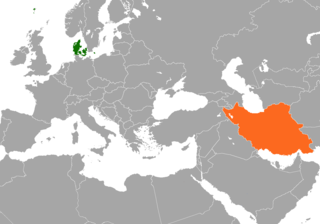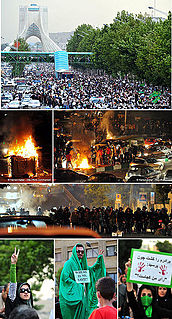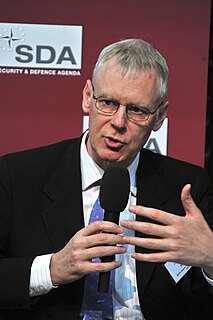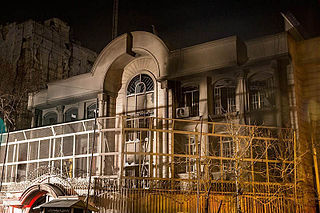Related Research Articles

The foreign relations of Iran are the economic and diplomatic relationships between the Iranian government and governments of other countries. Geography is a very significant factor in informing Iran's foreign policy. Following the 1979 Iranian Revolution, the newly formed Islamic Republic, under the leadership of Ayatollah Khomeini, dramatically reversed the pro-American foreign policy of the last Shah of Iran Mohammad Reza Pahlavi. Since then the country's policies have oscillated between the two opposing tendencies of revolutionary ardour to eliminate Western and non-Muslim influences while promoting the Islamic revolution abroad, and pragmatism, which would advance economic development and normalization of relations. Iran's bilateral dealings are accordingly sometimes confused and contradictory.

Ebrahim Yazdi was an Iranian politician, pharmacist, and diplomat who served as deputy prime minister and minister of foreign affairs in the interim government of Mehdi Bazargan, until his resignation in November 1979, in protest at the Iran hostage crisis. From 1995 until 2017, he headed the Freedom Movement of Iran. Yazdi was also a trained cancer researcher.

Death to America is an anti-American political slogan and chant. It is used in Iran, Afghanistan, Lebanon, Yemen, Iraq, and Pakistan. It has been used in Iran since the inception of the Iranian Revolution in 1979. Ruhollah Khomeini, the first Supreme Leader of the Islamic Republic of Iran, popularized the term. He opposed the chant for radio and television, but not for protests and other occasions.

Iran–United Kingdom relations are the bilateral relations between the United Kingdom and Iran. Iran, which was called Persia by the West before 1935, has had political relations with England since the late Ilkhanate period when King Edward I of England sent Geoffrey of Langley to the Ilkhanid court to seek an alliance.

The first Persian envoy to Denmark arrived in 1691 in order to negotiate the release of the Iranian-owned cargo of a Bengali ship seized by the Danish fleet. The Iranian diplomat had been issued with diplomatic credentials by Suleiman I of Persia and opened negotiations with King Christian V of Denmark. He was unable to secure the release of the cargo.

Iran–Pakistan relations covers the bilateral relations between the adjacent states of Iran and Pakistan. After Pakistan gained its independence in August 1947, Iran was one of the first countries to recognize its sovereign status. Relations between Shi'a-majority Iran and Sunni-majority Pakistan became greatly strained due to sectarian tensions in the 1980s, as Pakistani Shi'a Muslims claimed that they were being discriminated against under the Sunni-biased Islamization program being imposed throughout Pakistan by the military dictatorship government of then-President, General Muhammad Zia-ul-Haq. Following the 1979 Islamic Revolution, Iran and Saudi Arabia gradually began to use Pakistan as a battleground for their proxy sectarian conflict, and Pakistan's support for the Deobandi Taliban organization in Afghanistan during the civil wars in the 1990s became a problem for Shi'a Iran, which opposed a Taliban-controlled Afghanistan.

Iran and Saudi Arabia have had no diplomatic relations following the attack on the Saudi embassy in Tehran on January 2016 after Saudi Arabia executed Sheikh Nimr al-Nimr, a Shia cleric. Bilateral relations between the countries have been strained over several geopolitical issues such as the interpretations of Islam, aspirations for leadership of the Islamic world, oil export policy and relations with the United States and other Western countries.

Canada and Iran have had no formal diplomatic relations since 2012. Canadian consular and passport services are provided through other Canadian diplomatic missions in other countries in the Middle East while Iran maintains an interests section at the Embassy of Pakistan in Washington, D.C. The government headed by PM Justin Trudeau which took office in 2015, has reportedly been reviewing relations with Iran and, like most countries, lifted most of its economic sanctions following the Iran nuclear agreement in July 2015.

Protests against the results of the highly controversial 2009 Iranian presidential election, a disputed victory by President Mahmoud Ahmadinejad, in support of opposition candidates Mir-Hossein Mousavi and Mehdi Karroubi, occurred in major cities nationwide from 2009 into early 2010. The protests were titled the Iranian Green Movement by its proponents, reflecting Mousavi's campaign theme, and Persian Awakening, Persian Spring or Green Revolution, reflecting the "Persian identity" of Iranians and the so-called "colour revolution" theme.
Following the 2009 Iranian presidential election, protests against alleged electoral fraud and in support of opposition candidates Mir-Hossein Mousavi and Mehdi Karroubi occurred in Tehran and other major cities in Iran and around the world starting after the disputed presidential election on 2009 June 12 and continued even after the inauguration of Mahmoud Ahmedinejad as President of Iran on 5 August 2009. This is a timeline of the events which occurred during those protests.

Sir Simon Lawrance Gass is a British civil servant. Since 2019, he has chaired the Joint Intelligence Committee and he also currently serves as the British Prime Minister's representative on Afghanistan. Between 2018 and 2019, he was the Commandant of the Royal College of Defence Studies. During his diplomatic career, he served as British ambassador to Greece and to Iran.

The 2011 attack on the British Embassy in Iran was a mob action on 29 November 2011 by a crowd of Iranian protesters who stormed the embassy and another British diplomatic compound in Tehran, Iran, ransacking offices and stealing documents. One small building was set on fire during the incident and several people were injured. The Iranian government publicly condemned the violence.

The Embassy of the United Kingdom in Tehran is the United Kingdom's diplomatic mission to the Islamic Republic of Iran. It is located at 198 Ferdowsi Avenue in Tehran.
On 11 May 2010, the Pakistan Ambassador to Iran, H.E. Mohammad Bax Abbasi, survived an assassination attempt in Tehran. The Pakistani ambassador was injured including with his two guards who were killed and subsequent damaged to the High Commission's car. This was a second attack on Pakistan mission; the first attack took place in the Pakistan embassy in 2009.
The 2003 attack on the Pakistan Embassy in Kabul occurred when up to 500 Afghan protesters overran the embassy of Pakistan on 9 July 2003. It was the second major attack since 1995, when the embassy was also assaulted by Afghan protesters.

The Embassy of Iran in London is the diplomatic mission of Iran in the United Kingdom. It is located in a terrace overlooking Hyde Park in South Kensington, Westminster, London, next to the embassy of Ethiopia. Iran also maintains a Consular Section at 50 Kensington Court, South Kensington. The embassy building, along with the Ethiopian Embassy and the Polish Institute and Sikorski Museum, is one of a group of Grade II listed stucco buildings.
Nimr Baqir al-Nimr was a Shia cleric and critic of the government in Saudi Arabia, who was beheaded on 2 January 2016, one of 47 people executed that day for terrorism offenses. Others executed included Sunnis who had been convicted of involvement in terror attacks linked to al-Qaeda which took place in 2003. News of the killings triggered international demonstrations, and condemnation by nations, supranational organizations, and human rights groups.

The Embassy of the Kingdom of Saudi Arabia in Tehran was the diplomatic mission of Saudi Arabia in Iran until January 2016. Direct bilateral diplomatic relations between the two governments were severed following the mob attack and sacking of the embassy in January 2016.

The 2016 attack on the Saudi diplomatic missions in Iran was a mob action on 2 January 2016 by protesters against the execution of a prominent Saudi Arabian Shi'a cleric. Mobs stormed the embassy in Tehran and the Saudi consulate in Mashhad and ransacked them. The embassy building was set on fire with Molotov cocktails and petrol bombs. During the attacks, the police arrived and dispersed protesters from the embassy premises and extinguished the fire.
The 2021 anti-Pakistan protests are a series of protests against Pakistan occurring in Afghanistan, India, Iran, the United States and other countries in opposition to alleged Pakistani involvement in the war in Afghanistan and the subsequent Panjshir conflict.
References
- 1 2 McGinnis, Dan (November 29, 2011). "History of Attacks on Foreign Embassies in Iran". Yahoo News. Retrieved 9 August 2013.
- ↑ "Pak Embassy in Tehran attacked". SANA. Archived from the original on 7 March 2009. Retrieved 9 August 2013.